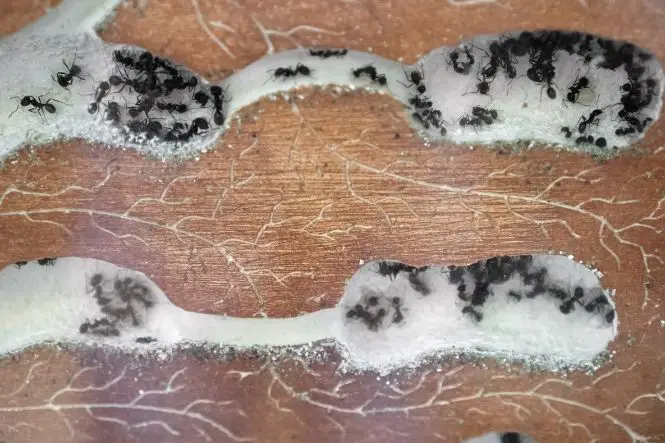Ants are insects and are from the order Hymenoptera, the same order as wasps and bees. They were first seen about 110 to 130 million years ago. Ants are 0.75 to 52 mm long, and are usually black or red, with a few species that are green. Ants make up about 15 to 20% of the biomass (weight of living creatures) in the world.
There are more than 50 types of ants in the UK, but the most common are Lasius niger, the common black ant; Lasius flavus, the yellow meadow ant; and Myrmica ruginodis, the red ant. Myrmica ruginodis bite, but Lasius niger and Lasius flavus do not.
Table of Contents
Ant Colonies
Ants live in colonies or nests, in groups of just a few to millions, and are found almost all around the world. Like honey bees, ants work together in very organised groups known as ‘superorganisms’.
‘Castes’ of Ants
In an ant colony, there are different ‘castes’. Though these are the same type of ants, and are all related, they can look very different. In a colony of Lasius niger, there will be queen, worker and male ants. Other types of ants also have soldiers, which are larger.
There is only one queen in a Lasius niger colony. The queen’s role is to lay eggs. Lasius niger worker ants are all female, and collect food, look after the eggs and larvae (young ants), and repair and defend the nest. Worker ants do not lay eggs. Male ants are small and winged and fertilise the new queens, and then die within a few days.
Keeping Ants
Myrmecologists are people who study ants, and a formicarium is a vivarium (an enclosed area for keeping animals and plants) especially for ants. Vivaria (plural of vivarium) can be as small as a large bottle or as big as a room or a house, but formicaria (plural of formicarium) are usually small enough to fit on a desk or table. Formicaria (also called ‘ant farms’) are available from some pet shops or on the Internet, but it is easy to build one.
Starting a Formicarium – Accommodation
Slim ant farms allow a better view of the ants’ nest. A tank is a more natural environment for the ants, but they will tunnel away from the glass, so be less visible. Adding a foraging box with a tube will allow a good view of the worker ants going to find food. Fill the tank with fine soil or sand. If the formicarium is inside a house, classroom or office, make sure that the ants cannot escape.
Starting a Formicarium – Ants
Lasius niger are probably the easiest type of ant to keep in a formicarium, especially, as they do not bite.
In the summer, often in July or August, new winged queens and males take flight and mate. The easiest way to start a colony is to capture a queen after she is fertilised. The queen ants are bigger than ordinary ants, and will be on the ground as they pull their wings off after mating. A number of queens can be carried back home in a container together, but must be housed separately. Once in the tank, the queen will lay eggs – these will become the new worker ants.
Feeding the Ants
Ants will eat insects, fruit and vegetables, and they like sweet things (they will invade the jam sandwiches at a picnic). Some pet shops and online shops sell ant food.




